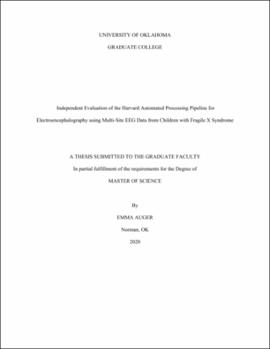| dc.description.abstract | The Harvard Automatic Processing Pipeline for Electroencephalography (HAPPE) in conjunction with The Batch Electroencephalography Automatic Processing Platform (BEAPP) is a computerized EEG data processing pipeline specifically designed for multiple site analysis of populations with neurodevelopmental disorders. This pipeline has been validated in-house by the developers but external testing using real-world datasets remains to be done. We collected resting and auditory event related data within a clinical trial for 100 children ages 3-6 years with Fragile X Syndrome. The trial encompasses 6 sites using several different EEG systems. This data set represents an ideal test of the new processing pipelines because the data comes from a population with typically high amounts of artifact as well as from different sites and systems. Therefore, we used this rich dataset to evaluate the software’s noise reduction techniques, data standardization features, and data integration in comparison to traditional manualized methods of processing. A MANCOVA was used to examine several measures of data post-processing and was found to be significant. Univariate results indicated that the HAPPE/BEAPP pipeline resulted in greater trials retained (F(4,24) = 5.80, p = 0.02), variance retained through ICA (F(4,24) = 39.74, p < 0.01), and smaller kurtosis (F(4,24) = 4.29, p = 0.049) than a manual pipeline for task-related data. No significant differences were found in signal-to-noise ratio (SNR) (F(1,24) = 0.18, p = 0.68). We did observe an overall loss of signal in the HAPPE/BEAPP pipeline, which is supported by the decrease in kurtosis. In order to further explore the reduction in signal, we processed simulated data in both pipelines. The simulated data was composed of simulated brain, pink noise, and real artifact. We measured correlations between the post-processed data from each pipeline and the pure simulated brain signal. Using a paired samples t-test we determined that the correlation between the pure signal and processed data was significantly higher for the manually processed data (M = 0.96, SD = 0.03) compared to the HAPPE processed data (M = 0.29, SD = 0.03); t(55) = 105.87, p < 0.01. In conclusion, data processed using HAPPE has many benefits including less active processing time and artifact reduction without removing segments. One major drawback is an overall reduction of signal. It eliminates noise and artifact at the cost of reducing signal. Importantly the SNR in the real data was not significantly different between the manually processed data and the HAPPE processed data, so the signal reduction may not negatively affect outcome measures. Therefore recommended implementation of the HAPPE pipeline for neurodevelopmental populations depends on the goals and priorities of the research. | en_US |

